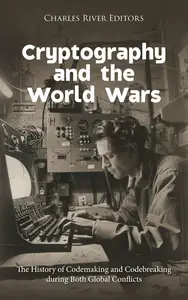
Free Download Cryptography and the World Wars: The History of Codemaking and Codebreaking during Both Global Conflicts
by Charles River Editors
English | December 5, 2024 | ASIN: B0DPRBMMT7 | 111 pages | PDF | 55 Mb
World War I stood apart in many ways from earlier wars, not least in the way that it reached to nearly every corner of the planet and involved a noticeable segment of humanity's collective resources. Battles erupted not only on land and the sea's surface as they had for centuries, but also in the ocean depths and the windswept heights of the sky.
Nearly every conceivable terrain saw use as a battlefield: the neat farmland and small towns of Western Europe; the streets of major cities; thick forests; open steppes stretching for hundreds of miles; deserts in Africa; rugged mountain ranges; and many other regions of the globe. But one of the war's most crucial struggles happened in the realm of the unseen, inside the human mind and amid the invisible flow of radio waves. Every war is a battle of wits as intelligence-gathering, tactics, and strategies clash, from the level of individual action up to the grand, overarching schemes of generals and statesmen. Intelligence took on a freshly urgent aspect in the Great War, however, as the fates of offensives, armies, and nations came to hang on the struggle to decrypt vital enemy radio traffic and military communications.
During the Second World War, cryptography suddenly became a significant factor in warfare because of mid 20th-century advances in communications technology. With radios small and common enough to be fitted into most individual vehicles and readily carried in a man-portable form, information and orders flowed from supreme headquarters to individual squad leaders, tanks, and soldiers at the front and back again.
Complex radio networks connected armies to their other elements almost like a nervous system, making unprecedented tactical and strategic coordination between units hundreds of miles apart not only possible but swift and, in some cases, efficient. Decrypting these signals or protecting their contents from enemy spying became one of the touchstones of victory or defeat. "Information warfare" arrived well ahead of the modern computer and satellite networks. The Allies expended much more effort on decrypting Axis codes than the Axis spent attempting to decipher theirs. Standing on the offensive for much of the war, the Germans felt less need for code-breaking than the Allies. Though they found intelligence useful, it had less value to the Wehrmacht's planners, who needed only moderate detail about enemy movements to plan a successful strategy, while leaving tactics in the highly capable hands of small unit leaders trained to take the initiative and react fluidly to the actual battlefield situation.
Even more oddly, Axis leaders and scientists consistently failed to identify the breach in their own codes, despite finding themselves constantly confronted by evidence suggesting just such a problem. With almost amusing irony, an ULTRA intercept listened in on a wireless conversation between Albert Kesselring, the skilled leader of the German defense in Italy in 1943 and 1944, and his trusted subordinate Lemelson: Kesselring complained, "The enemy always comes on the boundaries." Lemelson replied, "The Devil knows how he always finds where we are."
At a more personal level, the struggle to gain the upper hand in intelligence sometimes resembled the Description of a pulp adventure novel. While much of the hard work occurred in bland offices located in British manor houses, government buildings, or American labs, moments of intense human drama also punctuated the cryptographic struggle.
Code:
Bitte
Anmelden
oder
Registrieren
um Code Inhalt zu sehen!